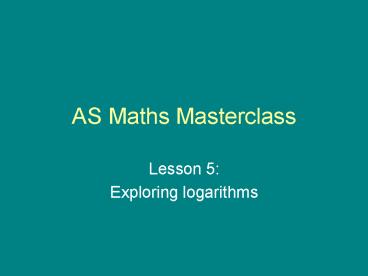AS Maths Masterclass - PowerPoint PPT Presentation
1 / 16
Title:
AS Maths Masterclass
Description:
Computer games: measuring algorithm efficiency. Cinema: flicker in a motion picture ... Multiplication rule: Division rule: Power rule: Reciprocal rule: Power of zero: ... – PowerPoint PPT presentation
Number of Views:15
Avg rating:3.0/5.0
Title: AS Maths Masterclass
1
AS Maths Masterclass
- Lesson 5
- Exploring logarithms
2
Learning objectives
- The student should be able to
- relate indices to logarithms and solve simple
indicial equations - apply the laws of logarithms to simplify
mathematical expressions - solve simple logarithmic equations using the laws
of logarithms
3
Why bother with logs ?
- Thanks to John Napier/ Henry Briggs 1615
- they were used to simplify very large
calculations in physics and astronomy.
4
But are logs actually used nowadays ?
- Finance compound interest
- Photography/ computing image compression
- Computer games measuring algorithm efficiency
- Cinema flicker in a motion picture
- Music pitch, acoustics, sound intensity
- Chemistry ph scale, Newtons law of
cooling - Physics radioactive decay, capacitor
discharge - Biology/ Economics/ Geog. population growth
- Geology earthquakes measured on the richter
scale.
5
Recall indices from GCSE ?
- Multiplication rule
- Division rule
- Power rule
- Reciprocal rule
- Power of zero
- Power of a product
6
What is a logarithm?
- The log of a number to a given base is the
- index of the power to which the base must
- be raised in order to obtain the original
- number.
- e.g. when
- If then x is called
- the log of N to the base a, written
7
Common logs and Natural logs
- If the base is 10 we say that the log is ..
- common. We write log or just lg
- If the base is e (2.718 281 828 ) then we
- say that the log is ..
- natural. We write ln
- Extension activity investigate the number e.
8
Evaluating logarithms
- If we write instead of
- then we can easily find logs to any base
- provided the number has a nice
- relationship.
- E.g. Let then
- Hence, x 4 since 3.3.3.3 81
Click here to practice finding logs to any base
(nice numbers) Click here to view the Logarithm
spreadsheet.
9
Moving towards the laws of logs
- We all know that
- so by definition,
- In addition, we all know that
- and so again by definition,
- We now need to examine equivalent laws
- for logs like we had for indices
10
The first law of logs
- The log of a product is the sum of the logs
- i.e. Prove that
- Let u and v
- Then, by definition we have and
- Hence,
- so by definition, u v
- Finally,
11
The power law
- The log of a number to a power is the product of
- the power with the log of the number
- i.e. Prove that
- Let u so and
- Hence,
- so by definition,
- From which,
12
Practice with the log laws
- Lets see how these laws work out in practice.
- Teacher clicks here for demonstration of log laws
with numbers - Students click here to practice the algebra of
log laws
Extension activity Click here for harder
questions using the log laws
13
Changing the base
- Whenever the numbers are not nice, we can
always - change the base to one more convenient.
- Prove
- Let u and so
- Hence,
- so meaning that u
- Finally,
14
Practice with change of base
- Click here to practice change of base for
"awkward logs"l - Click here for the IWB exercise on logs
15
Simple indicial equations
- If, when solving equations we have a variable in
the power, - then we say that we have an indicial equation
- We can now solve indicial equations by either
- (a) changing the base or
- (b) taking logs and applying the power law
- Click here for some indicial equations using
method (b)
16
Harder indicial and log equations
- Three index terms is likely to lead to a
- quadratic equation.
- Click here to look at some quadratic indicial
equations - Click here to solve logarithmic equations
- Extension activity Click here to try some harder
log equations






























![Download NCERT Solutions for Class 10 Maths [ Free PDF ] PowerPoint PPT Presentation](https://s3.amazonaws.com/images.powershow.com/9492370.th0.jpg?_=202009160210)
